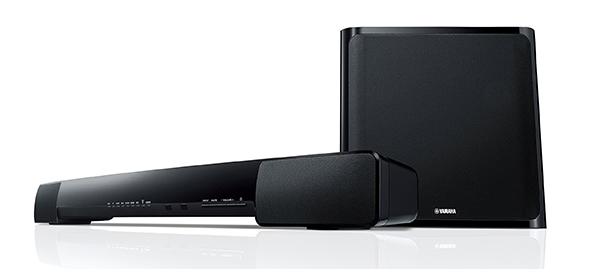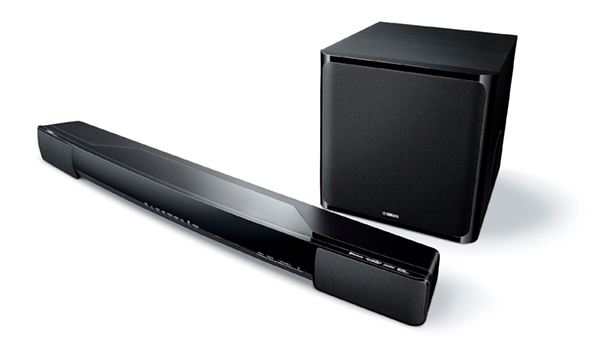Tom's Guide Verdict
Yamaha's YAS-203 soundbar creates a big, immersive sound while keeping the price affordable.
Pros
- +
Wide field of sound
- +
Rich bass
- +
Clear dialogue and vocals `
Cons
- -
No HDMI
Why you can trust Tom's Guide
Sound enriches the grand illusion of video entertainment, making for a more immersive movie- or TV-watching experience. In your home, you can't beat a full 7.1 or 5.1 home theater surround sound system for sucking you into a movie, but those setups can be costly and difficult to use. Yamaha's YAS-203 soundbar aims to take the pain and cost out of home theater sound, producing big sound at an affordable price.
Design
The YAS-203 looks like many soundbars: a long, shallow bar that's designed to be placed below or above your TV. At 35 inches wide, the YAS-203 should fit well with most moderate-size sets, those between 42 and 32 inches. Placed under a 55-inch Panasonic P55ST60, it appeared overmatched, though the sound turned out to be big enough to work with a screen that size.

The unit features easy-to-access audio connections on the back: optical digital, coaxial digital (labeled BD/DVD) and analog RCA stereo. It also includes Bluetooth for streaming music from a computer or mobile device. The YAS-203 lacks HDMI inputs or outputs, which means you can only control sound, not video inputs, and there's no on-screen display for setup or status.
MORE: Our Favorite Soundbar Speakers
Instead, the Yamaha relies on green indicator lights on the front of the main soundbar to indicate which audio input is active, as well as whether surround sound is engaged. Those at-a-glance indicators are convenient, but when you're trying to access deeper features, such as specific surround modes specialized for movie, music or sports, you can't tell which mode you're in. You have to turn to a mobile device and the free Home Theater Controller app for that.

The main unit features two 2.13-inch drivers, slightly smaller than the 2.36-inch drivers in Sony's HT-CT370. But the YAS-203 makes the most of those (see Audio Performance for more about that). The Yamaha's 12.5 x 11.5 x 11.4-inch wireless subwoofer is larger than those that come with the Sony HT-CT370 or Vizio S4251w-B4 5.1 surround soundbar, and the Yamaha product produces better bass as a result.
Setup and Use
The YAS-203 was simple to set up. I connected the included optical-digital cable from my TV to the back of the unit; the wireless subwoofer connected with the main soundbar as soon as I plugged in the subwoofer.
Get instant access to breaking news, the hottest reviews, great deals and helpful tips.
The YAS-203 can decode Dolby Digital and DTS signals, though I found that my TV wasn't passing these signals through to the soundbar. Instead, I needed to connect my Blu-ray player directly to the soundbar; I used the coaxial digital input for that.

The soundbar offers a few settings on the remote (or within the Home Theater Controller app, available for iOS and Android) that you can use to customize for your environment. You can adjust the subwoofer level and use the "bass extension" feature to add more low-end to the mix. You can also engage Clear Voice to boost dialogue. The Univolume button is aimed at late-night watching, and promises to prevent volume levels from spiking suddenly. You can also use audio delay if the video and audio look out of sync.
The app makes it much easier to tell levels and which of the five surround-sound modes you've engaged: TV Program, Movie, Music, Sports or Game. I found Movie and Music offered the best sound quality. The app itself could use refinement, though; I frequently received error messages in Chinese when I launched the app on my iPhone.
You can program the unit to respond to the volume controls of your TV's remote, meaning you don't have to turn to the Yamaha remote as often. Even better, the soundbar has a built-in IR repeater; this is handy if the soundbar blocks your TV's IR sensor — it repeats the signal through an emitter on the back of the soundbar.
Audio Performance
For a relatively small soundbar, the YAS-203 produces a big sound. Not only does it get plenty loud enough to fill a medium-to-large room, it also creates the illusion of a wide field of sound — the audio spreads out before you. This makes watching movies and TV a more immersive experience.

While I watched Justified, the YAS-203 produced clear dialogue, and I had no problem understanding Boyd Crowder's thick drawl. The subwoofer produces better detail in low-end effects than smaller units, such as the one that comes with Sony's HT-CT370. Instead of just a dull rumble as the Batmobile raced through Gotham in The Dark Knight, I could hear the rubber-on-the-road details that create the effect.
When decoding Dolby Digital or DTS, the YAS-203 really shines. During the club scene shootout in John Wick, the soundbar nicely handled the deep, throbbing soundtrack and the clatter of gunfire, producing a rich soundscape that complemented the on-screen action.
For music, the YAS-203 takes advantage of aptX technology to improve the quality of Bluetooth audio streams. The subwoofer again greatly enhanced the listening experience, pumping out the bass line that drives D'Angelo's "The Charade." Vocals on songs such as "Uptown Funk" by Mark Ronson featuring Bruno Mars sounded clear and bright, as did the horns. The midrange tones on some songs fell flat, but overall the soundbar is on par with others in the price range as a music system.
Bottom Line
With impressive sound in an affordable package, the Yamaha YAS-203 makes an attractive option to bolster your TV's sound. It's simple to set up and use, though some people may prefer the more feature-rich Sony HT-CT370, which costs just $50 more and includes HDMI inputs. But the YAS-203 delivers more-detailed bass and a wider field of sound — important aspects of the sound experience.

Michael Gowan is a freelance technology journalist covering soundbars, TVs, and wireless speakers of all kinds of shapes and sizes for Tom’s Guide. He has written hundreds of product reviews, focusing on sound quality and value to help shoppers make informed buying decisions. Micheal has written about music and consumer technology for more than 25 years. His work has appeared in publications including CNN, Wired, Men’s Journal, PC World and Macworld. When Michael’s not reviewing speakers, he’s probably listening to one anyway.

